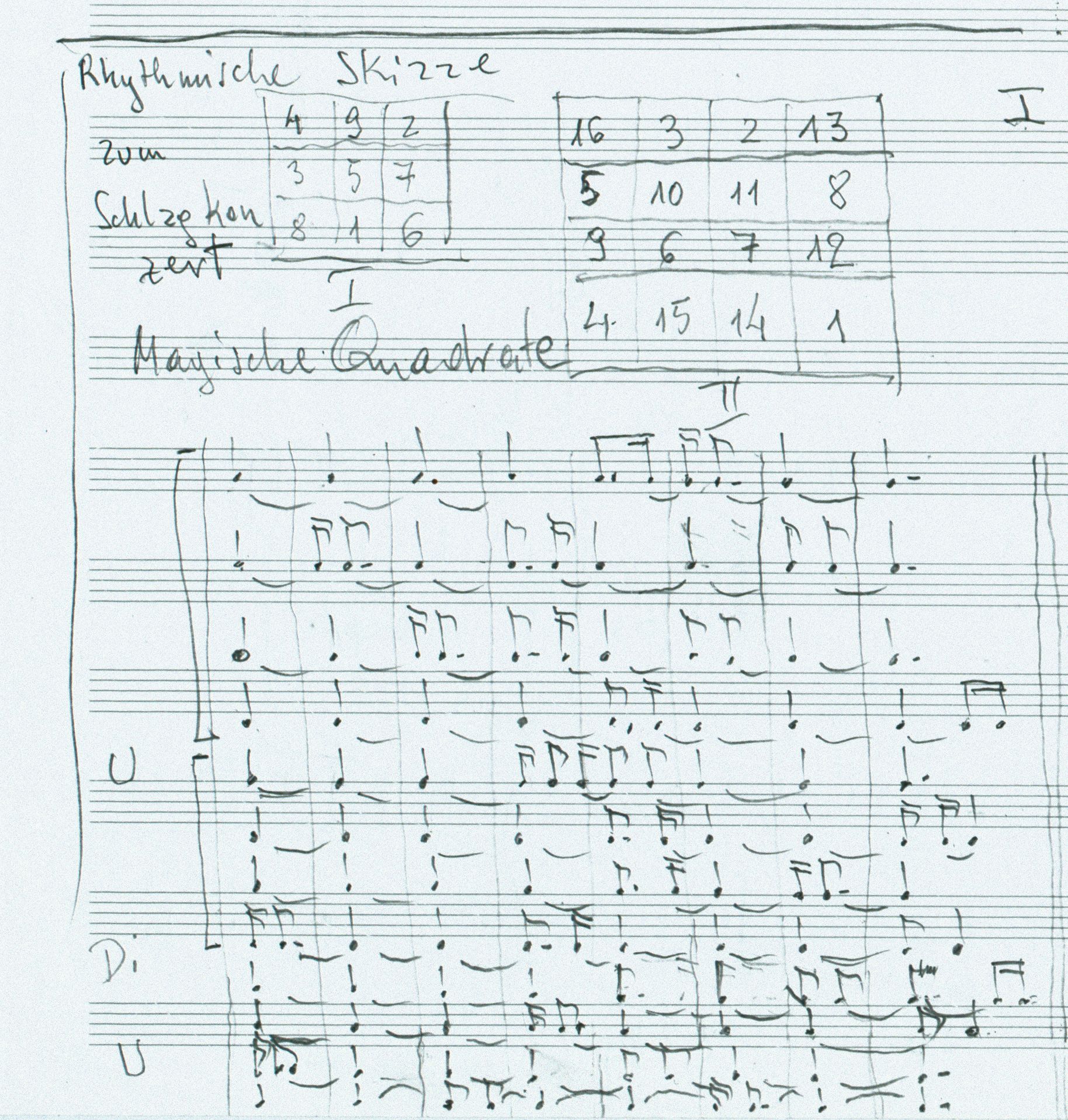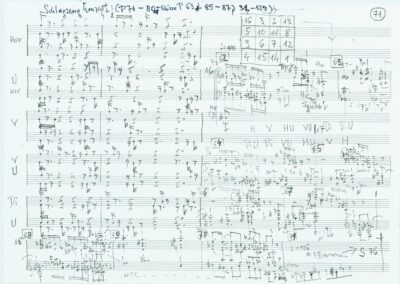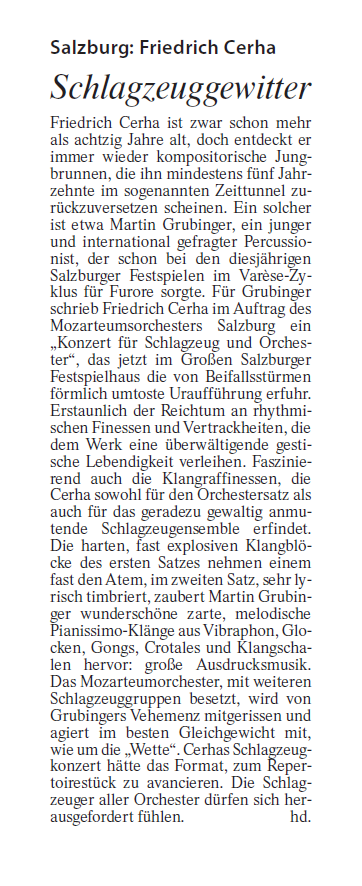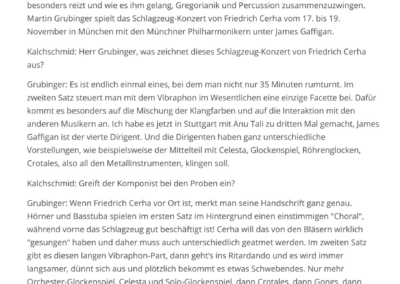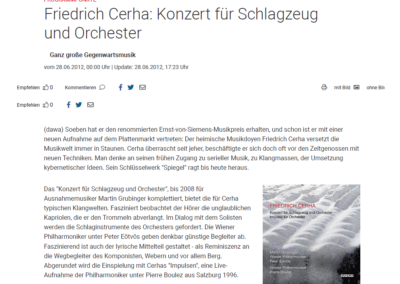Konzert für Schlagzeug
und Orchester
Under the Sign of Jupiter
Monumentum
Ein Buch von der Minne
The "Magic disc" of an amulet
Engraving on silver, diameter: 4.3 cm, Europe, 16th–18th century
For centuries, spiritual amulets were marked with special symbols and often inscribed with magic squares, as seen here. The Square of Jupiter (4 x 4) is shown here in Hebrew lettering, with the corresponding planetary symbol displayed on the back. The square plays an important role in several of Cerha’s compositions.
Source: © The Trustees of the British Museum
In 2012, Cerha met one of his most important musical interpreters:
young drummer Martin Grubinger.
Martin Grubinger interviews Friedrich and Gertraud Cerha
„KlickKlack“, BR-Klassik, 14.6.2012
They met for the first time in the new millennium. Grubinger was in his early twenties and had recently attended a performance of Cerha’s Chansons. The performer of the Chansons was HK Gruber, who then introduced Cerha and Grubinger—the beginning of an artistic liaison. Grubinger suggested that Cerha write him a percussion concerto, though it took some time before the request was fulfilled. “When I wrote it,” the composer recalls, “I had never heard Grubinger play, nor did I have any contact with him while I was working. I didn’t want to be influenced in any way. Today, however, I read that the piece fits him ‘to a T’ and—although he himself says it is the most difficult thing he has ever played—he has in fact made it his own with such bravado that one could assume that it was written for him.“ Joachim Diederichs: Friedrich Cerha. Werkeinführungen, Quellen, Dokumente, Vienna 2018, p. 113 Since the 2009 world premiere in Salzburg, the dynamic piece has been inextricably linked to the charismatic virtuoso.
Außenansicht
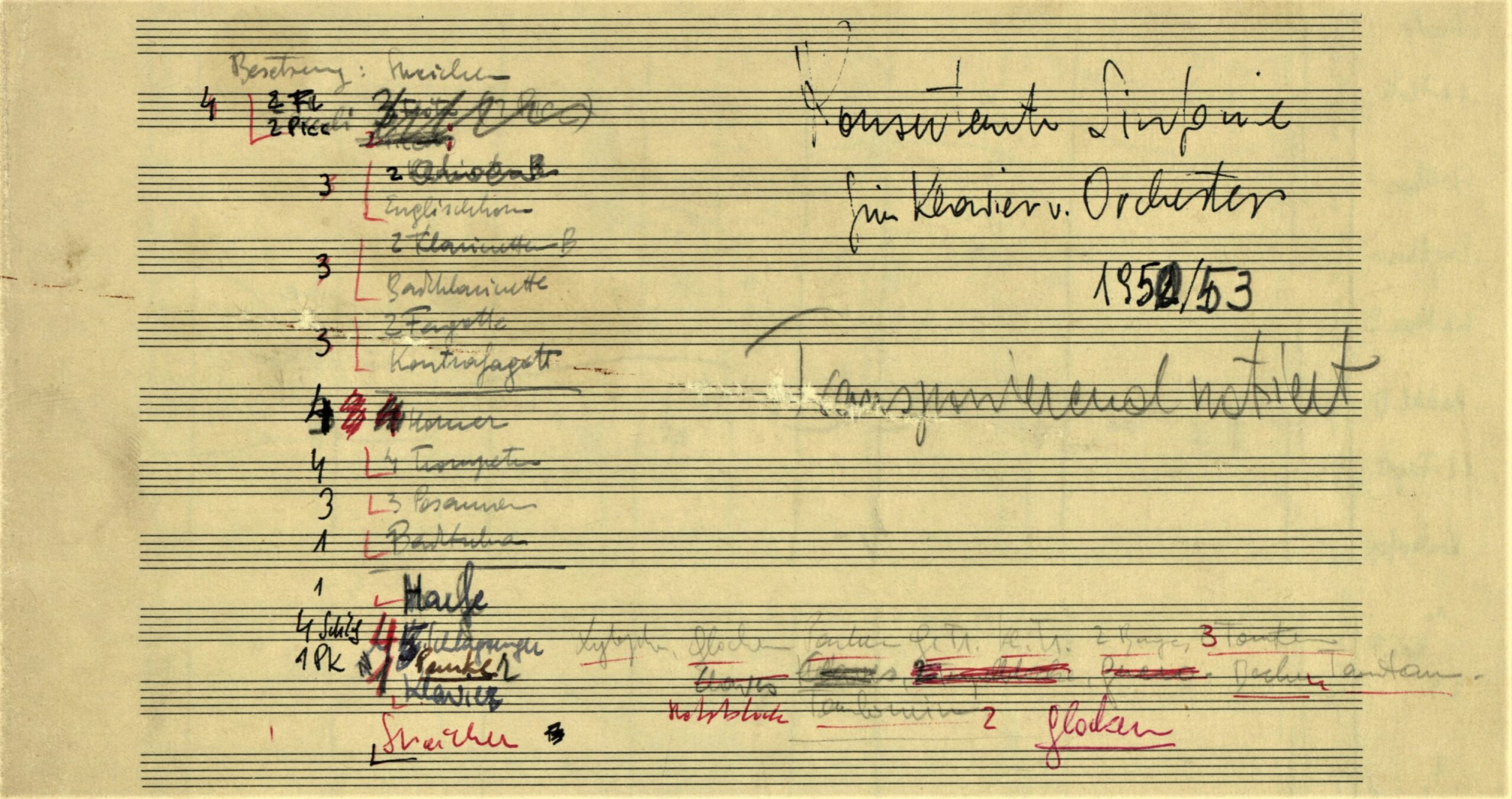
Cerha, Konzert für Klavier und Orchester, handwritten score, early version, 1954, AdZ, 00000039/3
Vienna, 1951: After some successful early works—mostly chamber music—Cerha wrote the first notes of a piano concerto accompanied by an orchestra. At that time it still bore the name “Concert Symphony”—an important detail: Cerha was battling with the historic genre of the solo concert, which no longer felt up to date. The mentality in 1950s Europe was evolving, and everyone was talking about the new genre of serial music. The ideals centred around differentiated, abstract but thoroughly structured sound formations. The arcs of tension and driving momentum typical of solo concerts were no longer de rigueur, were now rejected as relics of musical tradition. “This resulted in no concertos being written for a time and, when it did happen again, the concertante element was reduced to the isolation of the solo part, or did not arise at all due to the solo instrument being absorbed by the whole.“Schriften: ein Netzwerk, Vienna 2001, p. 250 It is partly due to these historical musical developments that it was decades before Cerha became comfortable with the format of the solo concerto. There were interim solutions, such as in Intersecazioni, composed in 1959: Here, a single violin takes on the role of an entire orchestral group. But it was not until much later, in the 1990s, that he finally broke through. A concerto for viola was the first result, then one for cello. In 1998—almost 50 years after he began composing—Cerha’s first piano pieces were born, now aptly and meaningfully named Konzert für Klavier und Orchester (Concerto for Piano and Orchestra). Cerha seems to have more than overcome any old reservations: The concerto format blossomed into numerous late works within his oeuvre. In the new millennium, from 2003 to 2008, he produced a core of virtuoso solo concertos, first honouring soprano saxophone, violin, and clarinet with compositions—and then finally also the drums. The musical acrobatics emerge here with the greatest clarity, and not through the wide and dazzling range of percussion.

Cerha, Konzert für Schlagzeug und Orchester, handwritten score, 2008, AdZ, 00000151/2
Brücke
It is rare that a composer remains stoically faithful to a single way of writing. Perspectives and approaches change almost inevitably, just as time cycles and changes course. Cerha’s evolution as a composer spans almost an entire century; it is only natural that his music has taken a wide variety of forms over the decades. Cerha’s late interest in the solo concerto genre is closely linked to a change in his compositional working methods. Even in his early piano concerto, which at the time did not bear his name, Cerha worked with the 12-tone method developed by Arnold Schönberg in the 1920s. However, Cerha was more free with the 12-tone rows than strictly dictated by the rules. For him, the focus was not on the system of ordering, on the “laws”, but on the music already playing out in his head. The applied system should not be the end in itself, but should instead be a support for bringing one’s ideas into context. It speaks for itself that Cerha never fully submitted to the trend of serialism that emerged a bit later. Compositions such as Relazioni fragili adopt the new techniques of the time, yet remain flexible in their details. Cerha’s attitude towards compositional ordering systems is equally flexible: He uses them freely, without dogma.
Among the ordering methods that Cerha himself repeatedly mentions, one is particularly characteristic of his work: The magic square of numbers. While 12-tone technique and serialism were still common compositional methods during the avant-garde, the square is a rather unique means of construction. It does, however, have a long cultural history: Arabic scholars invented magic squares during the time of Alexander the Great. They were originally used for spiritual purposes and were embossed onto amulets, for example. It was not until the fifteenth century, during the Renaissance, that they spread to the West. Published in 1533, The Books of Occult Philosophy by Agrippa von Nettesheim decisively contributed to their popularisation. “The polymath assigned squares with the dimensions 3×3, 4×4, 5×5, and so on, to the seven planets of the solar system as recognised at the time, in ascending order: Saturn, Jupiter, Mars, the Sun, Venus, Mercury, and the Moon. The magic squares all have something in common: The numbers of each row, column, and diagonal add up to the same sum, the magic number of the square. The total is always the same, thus putting the numbers in a very specific, mutually dependent relationship of order.Marco Hoffmann, „Barocke Chiffren? Konstruktion, Ausdruck und Metaphysik und Cerhas Tombeau aus den Drei Orchesterstücken“, in: Matthias Henke & Reinke Schwinning: Nach(t)musiken. Anmerkungen zur Instrumentalmusik Friedrich Cerhas, Siegen: universi 2021, pp. 79-108
Magic squares can be created with letters as well as numbers. One of the oldest word squares is the Sator Square, which was first documented as a mural in Pompeii and dates back to AD 55. It contains a sequence of Latin words that can be read forwards and backwards, a palindrome: SATOR (the sower) AREPO (a name of unknown origin), TENET (to hold), OPERA (with effort), and ROTAS (wheels). To this day, there is still speculation on the exact meaning of the sentence. The square found its way into the musical sphere through the work of Anton Webern. He mentions the “old Latin saying“Anton Webern, Der Weg zur Neuen Musik, Vienna 1960, p. 61 in his writing, and used it to build the 12-tone rows of his works—a starting point for Cerha, who admires Webern. He goes into more detail about the Sator Square in one of his essays:
The Latin palindrome that Webern was studying at the time of composing Konzert op. 24, and which he often later quoted, provides us with a good picture of his wishful thinking. A relationship between elements that is as understandable and rich as possible is made easier when things are reduced to a few basic requirements than when material has been piled up, because each change in an aspect leads to myriad complications. Extreme economy is therefore increasingly the order of the day—anything superfluous is eliminated.
Friedrich Cerha
Schriften: ein Netzwerk, Vienna 2001, p. 203
Webern’s use of the square led to highly concentrated musical structures with a complexity based on the close relationship of their components. Cerha’s artistic “questioning” of magic squares takes a different form: It is a more “sensual” game of numbers.
Cerha, private photograph of a commemorative plaque for Anton Webern, Mittersill (Salzburg), Cerha’s private photos, AdZ
Innenansicht
This percussion concerto is one of three works for which Cerha used a magic square. Another one is “Tombeau”, composed in 2011 as the final movement for Drei Orchesterstücke. “Regardless of any personal connotations, […] ‘Tombeau’ [is a] rather strictly structured piece,” notes Cerha.Joachim Diederichs: Friedrich Cerha. Werkeinführungen, Quellen, Dokumente, Vienna 2018, p. 124
To create the structure, he used a magic square made up of 25 fields, “that is assigned to Mars in Arabic mysticism.” The numbers dominate the music’s “DNA”: Cerha derived all notes from it, and ultimately all durations as well. However, it is also made very clear that construction and expression are not necessarily mutually exclusive. The emotionality that can be heard in the musical vocabulary is as merciless as the stringent order, telling of the unstoppable nature of time, of immobility, and the end.
Cerha, Drei Orchesterstücke – Tombeau, sketches of variations on the Magic square of Mars, 2011, AdZ, 000S0165/1
If one looks further back in the oeuvre, a third piece written in the early 1990s, Langegger Nachtmusik, also emerges as a work with a strict number structure. Cerha says: “In a detailed ordering scheme, I used a 16-digit magic square that Albrecht Dürer featured in his piece Melancholia written in 1514 and which results in the number 34 from many sides; in the Islamic tradition, this square was assigned to the planet Jupiter.“Schriften: ein Netzwerk, Vienna 2001, p. 263 The square taken up by Dürer can probably be considered the most popular of its kind. It is woven into the copper engraving described above using enigmatic, symbol-laden imagery that reflected the astrology of its time. It is uncertain whether the forces of Jupiter and Saturn (which, it is said, influence melancholy) are actually balanced against each other in the picture. However, it is relatively certain that Dürer was inspired by Nettesheim’s Occulta Philosophia. It was circulated as a handwritten manuscript in humanistic circles even before being printed and features both the Square of Jupiter and the Square of Mars. For his copper engraving, Dürer rearranged the rows and columns of the original square so that the bottom row features the number 1514, the year the image was made.
Albrecht Dürer, Melencolia I, 1514, copper engraving, 24.5 x 19.2 cm
Source: Wikimedia
Martin Grubinger introduces the instruments of the percussion concerto
Source: „KlickKlack“, BR-Klassik, 11.11.2010

Cerha, Konzert für Schlagzeug und Orchester, handwritten score, placement sketch, 2008, AdZ, 00000151/3
Three positions for three movements—a seemingly clean delineation between sound worlds. However, Cerha would not be Cerha if he did not search out a broader context. At the end, the drummer returns to the first group of instruments. This is where the piece does a “backflip”; the characteristic tonal structures of the first movement suddenly reappear. They not only bracket the concerto musically, they are also the result of the Square of Jupiter. Put bluntly, the magic numbers are what ensure the unity of the entire composition. Cerha clarifies:
The first and third sections of the first movement […] are characterised by eruptive blocks of sound; the drums dominate. In the orchestra, three layers of short notes are superimposed in a rhythmically complex ordering. The basis for this comes from a magic square in which the most diverse sequences result in the sum of 34. Only the soloist and a line of horns and tuba bring continuous movement. This creates an overall probing and insistent sound character. […] The final section of the third movement reaches back—of course not literally—to the happenings of the first movement, which was characterised by eruptive drum events. The piece ends with a repetition of the beginning, but sequenced as a mirror image, in cancrizans.
Friedrich Cerha
Joachim Diederichs: Friedrich Cerha. Werkeinführungen, Quellen, Dokumente, Vienna 2018, p. 113; 115
Just how precisely Cerha works with the Square of Jupiter can be seen from his sketches, where the square appears several times. One “rhythmic sketch” stands out in particular, helping illuminate the compositional process. Cerha “translates” the numbers of the square into rhythms in a specific way: The basic value of a sixteenth note, the smallest unit of the number 1, provides the foundation. All 16 numbers of the Square of Jupiter are built up from this. The largest number—16—is made up by 16 sixteenth notes (i.e., four beats). Several variations of the magic numbers are transferred in the sketch, with a “true to scale” transfer seen in the first four staves. The four staves represent the four lines of the square—16 note durations for 16 numbers. In four other staves, Cerha notates these exact durations again, but backwards. A “U” in front of it probably stands for “U-turn”, meaning the inversion of the tonal series. Two more variants also appear: In one, Cerha writes down the durations for the two diagonals of the square, and in the other he again drafts their mirrored forms (U). This results in a total of 12 duration rows, each with four durations (in line with the 4×4 arrangement).
In addition to the Square of Jupiter, Cerha also used a second magic square, a square of threes; the 3×3 rows and columns always add up to 15. In his Occulta Philosophia, Agrippa von Nettesheim allocates this square to Saturn—a striking detail, given that the astrological subtext is a subtle reference back to Dürer’s engraving and the melancholic character of the planet.
Cerha, Konzert für Schlagzeug und Orchester, sketches, Magic Squares, 2007, AdZ, 000S0151/65
These numbers, translated into rhythms, provide Cerha with a compositional “quarry” from which to draw his material. However, the Schlagzeugkonzert also shows us that the magic square is just a tool—a tool that Cerha uses differently from piece to piece, following his musical inspiration. While the translated tone durations of “Tombeau” are all maintained, thus creating a viscous sound, the material is used percussively in the drum concerto, creating “chiselled” forms. The sketches again provide excellent insight into Cerha’s working methods. The rhythms later found in the score are drafted in the sketches early on. The process: The note durations resulting from the magic numbers are lined up, always in sequences of four. Of this, however, only pulsations remain: Cerha puts a sixteenth note (the smallest base value of his rhythmical matrix) at the beginning of a new note duration. This is followed by a pause, until a new note duration begins. The result is a musical game between “empty spaces” and powerful surges. In a sense, the interplay represents the magic square’s search for balance: The shorter and longer pauses balance each other overall, giving space to the idea of always resulting in the same sum. This complex soundscape of distributed rhythms also has a homogeneous colour: Only wind instruments are heard—a special feature that at times evokes distant memories of big band sound.
Cerha, Konzert für Schlagzeug und Orchester, sketches, score of bars 27–31, 2007, AdZ, 000S0151/76
A closer look at the extensive sketches reveals that the magic numbers also found their way into the score in a different way than rhythmic transformation. In addition to the Square of Jupiter, Cerha also sketched 16 fifth chords on one page, assigned to the 16 numbers. He then used these elements to compose, with lineal patterns on the sketches showing us the pathways through the square. The details of how the numbers are assigned reveal that the chord rows are not necessarily the same as those of the rhythms; just as several rhythm rows are layered on top of each other, chords and rhythms are combined to form a complex whole in which the magic square shines through on several levels, all without revealing its secrets to the ear.
Cerha, Konzert für Schlagzeug und Orchester, sketches, chord drafts, 2007, AdZ, 000S0151/75
If one zooms out from the details again, layers can also be seen on a broader level. The abstract, almost architectural wind chords contrast with the solo percussion. Intricate rhythms are found here—but the score is untouched by the magic square. The movement patterns are free and (despite the compositional meticulousness) seem almost improvised. Ten tom-toms make up the main set of instruments, their pitches exactly prescribed, “contrary to custom”. Joachim Diederichs: Friedrich Cerha. Werkeinführungen, Quellen, Dokumente, Vienna 2018, p. 113 The third element is a kind of chorale melody played by the four horns and bass tuba, a mixture of sounds with majestic undertones. The melody is never broken: Predominantly long, the notes create a connection, joining the moving rhythms of the drums and wind instruments. In sum, the first movement (and the corresponding final section) proves to be a study in rhythmic layers, bringing together rhythm and melody, stringent structures and uninhibited design.
hr-Sinfonieorchester, Conductor: Andrés Orozco-Estrada, Martin Grubinger (percussion)
Complex sound structures such as the ones highlighted play an important role in the percussion concerto. Overall, however, the work does not emerge solely as an exploration of intricate musical architecture. The perspectives in the approximately 35-minute composition change, sometimes creating space for poetry. Cerha says that “Experiences in the silence of the night-time forest” like “the cracking of twigs, rustling in the leaves, the tired, soft calling of a bird” Joachim Diederichs: Friedrich Cerha. Werkeinführungen, Quellen, Dokumente, Vienna 2018, p. 113were inspiration for a passage in the second, slow movement—this time nature , not numbers, is turned into music. On the other hand, the approaches of the third movement are almost playful : There is, temporarily, “an interplay between the solo xylophone and the xylophone in the orchestra, with the “counter-soloist” imitating and continuing the soloist’s phrases”Joachim Diederichs: Friedrich Cerha. Werkeinführungen, Quellen, Dokumente, Vienna 2018, p. 115: virtuoso acrobatics and joyful, teasing music. The result? A piece that cannot be squeezed into the narrow confines of a square.




